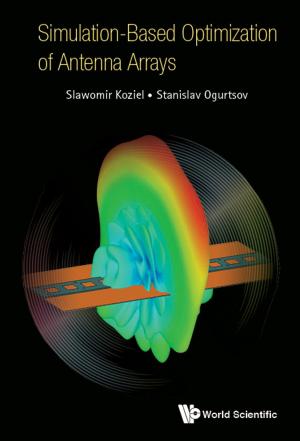Statistical Turbulence Modelling for Fluid Dynamics — Demystified
An Introductory Text for Graduate Engineering Students
Nonfiction, Science & Nature, Science, Physics, Mechanics, Technology| Author: | Michael Leschziner | ISBN: | 9781783266630 |
| Publisher: | World Scientific Publishing Company | Publication: | August 20, 2015 |
| Imprint: | ICP | Language: | English |
| Author: | Michael Leschziner |
| ISBN: | 9781783266630 |
| Publisher: | World Scientific Publishing Company |
| Publication: | August 20, 2015 |
| Imprint: | ICP |
| Language: | English |
This book is intended for self-study or as a companion of lectures delivered to post-graduate students on the subject of the computational prediction of complex turbulent flows. There are several books in the extensive literature on turbulence that deal, in statistical terms, with the phenomenon itself, as well its many manifestations in the context of fluid dynamics. Statistical Turbulence Modelling for Fluid Dynamics — Demystified differs from these and focuses on the physical interpretation of a broad range of mathematical models used to represent the time-averaged effects of turbulence in computational prediction schemes for fluid flow and related transport processes in engineering and the natural environment. It dispenses with complex mathematical manipulations and instead gives physical and phenomenological explanations. This approach allows students to gain a 'feel' for the physical fabric represented by the mathematical structure that describes the effects of turbulence and the models embedded in most of the software currently used in practical fluid-flow predictions, thus counteracting the ill-informed black-box approach to turbulence modelling. This is done by taking readers through the physical arguments underpinning exact concepts, the rationale of approximations of processes that cannot be retained in their exact form, and essential calibration steps to which the resulting models are subjected by reference to theoretically established behaviour of, and experimental data for, key canonical flows.
Contents:
- Statistical Viewpoint of Turbulence — Motivation and Rationale
- What Makes Turbulence Tick?
- Reynolds-Averaging
- Fundamentals of Stress / Strain Interaction
- Fundamentals of Near-Wall Interactions
- Fundamentals of Scalar-Flux / Scalar-Gradient Interactions
- The Eddy Viscosity
- One-Equation Eddy-Viscosity Models
- Two-Equation Models
- Wall Functions For Linear Eddy-Viscosity Models
- Defects of Linear Eddy-Viscosity Models, Their Sources and (Imperfect) Corrections
- Reynolds-Stress-Transport Modelling
- Scalar/Heat-Flux-Ttransport Modelling
- The ¯υ2 — ƒ Model
- Algebraic Reynolds-Stress and Non-Linear Eddy-Viscosity Models
Readership: Researchers and post-graduate students in the field of fluid dynamics.
Key Features:
- Emphasis on physical and phenomenological interpretation
- Broad range of models covered
- Strong emphasis on understanding the concepts and the rationale behind assumptions
- Avoidance of mathematical complexity that does not serve the objective of conveying understanding and insight
This book is intended for self-study or as a companion of lectures delivered to post-graduate students on the subject of the computational prediction of complex turbulent flows. There are several books in the extensive literature on turbulence that deal, in statistical terms, with the phenomenon itself, as well its many manifestations in the context of fluid dynamics. Statistical Turbulence Modelling for Fluid Dynamics — Demystified differs from these and focuses on the physical interpretation of a broad range of mathematical models used to represent the time-averaged effects of turbulence in computational prediction schemes for fluid flow and related transport processes in engineering and the natural environment. It dispenses with complex mathematical manipulations and instead gives physical and phenomenological explanations. This approach allows students to gain a 'feel' for the physical fabric represented by the mathematical structure that describes the effects of turbulence and the models embedded in most of the software currently used in practical fluid-flow predictions, thus counteracting the ill-informed black-box approach to turbulence modelling. This is done by taking readers through the physical arguments underpinning exact concepts, the rationale of approximations of processes that cannot be retained in their exact form, and essential calibration steps to which the resulting models are subjected by reference to theoretically established behaviour of, and experimental data for, key canonical flows.
Contents:
- Statistical Viewpoint of Turbulence — Motivation and Rationale
- What Makes Turbulence Tick?
- Reynolds-Averaging
- Fundamentals of Stress / Strain Interaction
- Fundamentals of Near-Wall Interactions
- Fundamentals of Scalar-Flux / Scalar-Gradient Interactions
- The Eddy Viscosity
- One-Equation Eddy-Viscosity Models
- Two-Equation Models
- Wall Functions For Linear Eddy-Viscosity Models
- Defects of Linear Eddy-Viscosity Models, Their Sources and (Imperfect) Corrections
- Reynolds-Stress-Transport Modelling
- Scalar/Heat-Flux-Ttransport Modelling
- The ¯υ2 — ƒ Model
- Algebraic Reynolds-Stress and Non-Linear Eddy-Viscosity Models
Readership: Researchers and post-graduate students in the field of fluid dynamics.
Key Features:
- Emphasis on physical and phenomenological interpretation
- Broad range of models covered
- Strong emphasis on understanding the concepts and the rationale behind assumptions
- Avoidance of mathematical complexity that does not serve the objective of conveying understanding and insight















